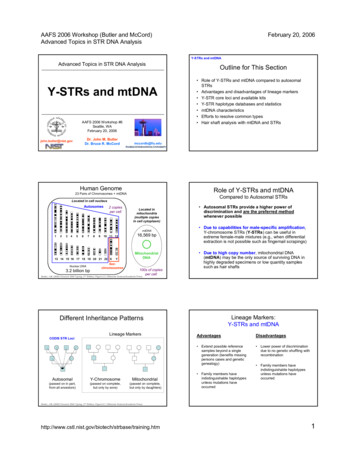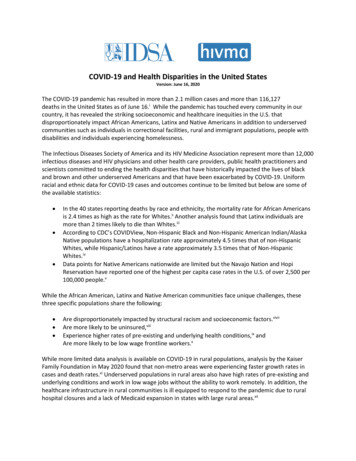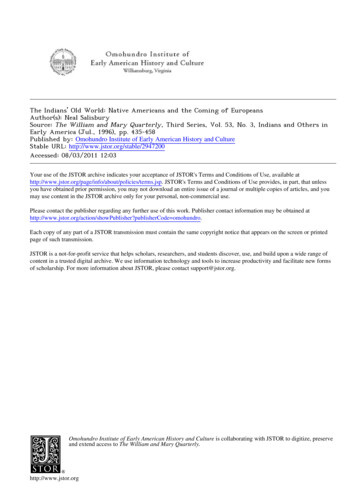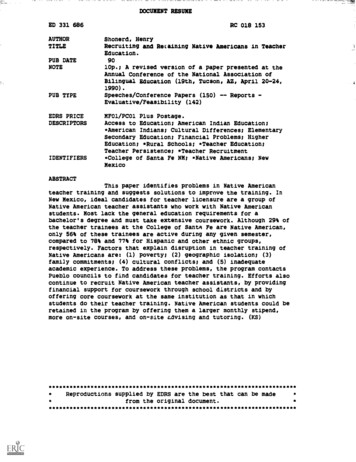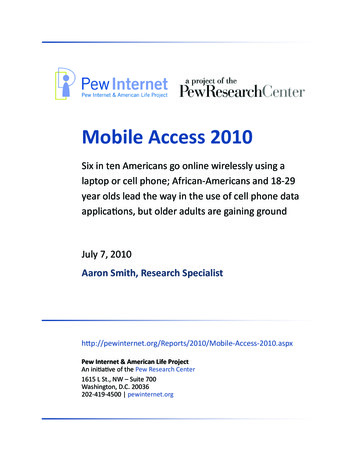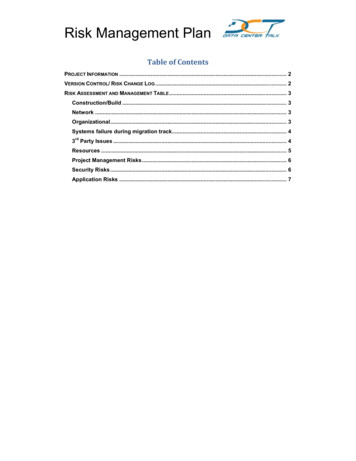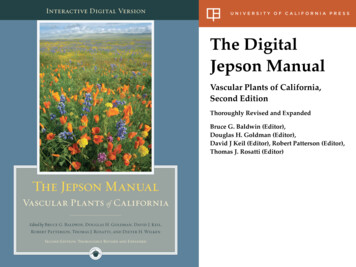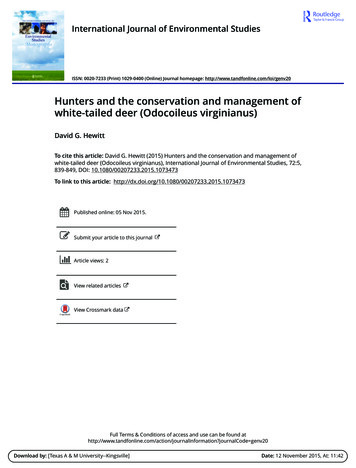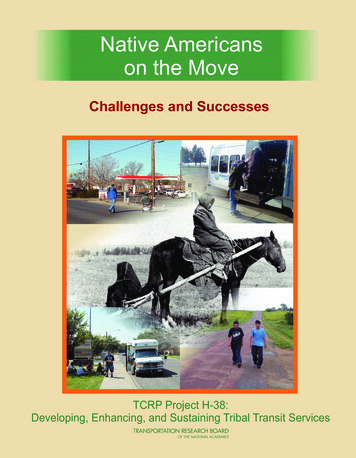
Transcription
Native Americanson the MoveChallenges and SuccessesTCRP Project H-38:Developing, Enhancing, and Sustaining Tribal Transit Services
AcknowledgmentsPanel MembersChair:Ms. Emma Featherman-SamOglala Sioux TransitTCRP Senior Program Officer:Stephan ParkerMs. Raquelle MyersNational Indian Justice CenterDr. Frederick J. “Fred” CowieConsultantLiaisons:Ms. Cathy MonroeFederal Transit AdministrationMs. Vivian A. PhilbinFederal Highway AdministrationMr. Michael FordAnn Arbor Transportation AuthorityMs. Lorna R. WilsonFederal Transit AdministrationMr. Richard RollandEastern Washington UniversityTribal Technical Assistance CenterMs. Cynthia GomezCalifornia Environmental ProtectionAgencyMr. Bernard AlkireMichigan Technological UniversityMr. C. John HealyFort Belknap Indian CommunityMr. Andy CoyleNational Rural Transit AssistanceProgramMr. Charles RutkowskiCommunity TransportationAssociation of AmericaMr. Mark R. HoffmanArizona DOTMr. Edward H. Hall IIIBureau of Indian AffairsMr. Shawn KlemensMenominee Public TransitMr. Byron BluehorseUniversity of Alaska, FairbanksTribal Technical AssistanceCenterMr. John P. SmithShoshone & Arapaho TribesMs. Arlene TemplerConfederated Salish and KootenaiTribesMr. Joseph MyersNational Indian Justice CenterMs. Gwen SaltNational Congress of AmericanIndiansMr. Dennis TrustyUnited Tribes Technical CollegeTribal Technical Assistance CenterMs. Martine A. MicozziTransportation Research BoardTechnical Activities DivisionTribes Submitting InformationAsa'carsarmiut TribeAssiniboine and Sioux Tribes of the Fort Peck Indian Reservation,MontanaBlackfeet Tribe of the Blackfeet Indian Reservation of MontanaBurns Paiute Tribe of the Burns Paiute Indian Colony of OregonCatawba Indian Nation (aka Catawba Tribe of South Carolina)Cherokee Nation, OklahomaChickaloon Native VillageChickasaw Nation, OklahomaChoctaw Nation of OklahomaCoeur d'Alene Tribe of the Coeur d’Alene Reservation, IdahoConfederated Salish & Kootenai Tribes of the Flathead Reservation,MontanaConfederated Tribes of the Colville Reservation, WashingtonConfederated Tribes of the Grand Ronde Community of OregonCoquille Tribe of OregonCowlitz Indian Tribe, WashingtonCraig Community AssociationCrow Tribe of MontanaEastern Band of Cherokee Indians of North CarolinaFlambeau Reservation of WisconsinFort Belknap Indian Community of the Fort Belknap Reservation ofMontanaHoulton Band of Maliseet Indians of MaineHualapai Indian Tribe of the Hualapai Indian Reservation, ArizonaIowa Tribe of OklahomaKalispel Indian Community of the Kalispel Reservation, WashingtonKaw Nation, OklahomaKiowa Indian Tribe of OklahomaKlamath Indian Tribe of OregonLac du Flambeau Band of Lake Superior Chippewa Indians ofWisconsinLummi Tribe of the Lummi Reservation, WashingtonMakah Indian Tribe of the Makah Indian Reservation, WashingtonMenominee Indian Tribe of WisconsinMescalero Apache Tribe of the Mescalero Reservation, New MexicoMinnesota Chippewa Tribe, Minnesota: Grand Portage Band GulkanaVillageMinnesota Chippewa Tribe: Leech Lake BandNarragansett Indian Tribe of Rhode IslandNavajo Nation, Arizona, New Mexico & UtahNorthern Cheyenne Tribe of the Northern Cheyenne IndianReservation, MontanaOglala Sioux Tribe of the Pine Ridge Reservation, South DakotaOneida Tribe of Indians of WisconsinOsage Tribe, OklahomaPaiute-Shoshone Indians of the Bishop Community of the BishopColony, CaliforniaPaiute-Shoshone Tribe of the Fallon Reservation and Colony,NevadaPoarch Band of Creek Indians of AlabamaPokagon Band of Potawatomi Indians, Michigan and IndianaPonca Tribe of NebraskaPueblo of Cochiti, New MexicoPueblo of Santa Ana, New MexicoQuinault Tribe of the Quinault Reservation, WashingtonRed Lake Band of Chippewa Indians, MinnesotaSantee Sioux Tribe of the Santee Reservation of NebraskaSeminole Nation of OklahomaSeneca Nation of New YorkShoalwater Bay Tribe of the Shoalwater Bay Indian Reservation,WashingtonSitka Tribe of AlaskaSnoqualmie Tribe, WashingtonSouthern Ute Indian Tribe of the Southern Ute Reservation, ColoradoSpirit Lake Tribe, North DakotaSquaxin Island Tribe of the Squaxin Island Reservation, WashingtonSt. Regis Band of Mohawk Indians of New YorkStanding Rock Sioux Tribe of North & South DakotaStillaguamish Tribe of WashingtonSuquamish Indian Tribe of the Port Madison Reservation,WashingtonSusanville Indian Rancheria, CaliforniaTurtle Mountain Band of Chippewa Indians of North DakotaWampanoag Tribe of Gay Head (Aquinnah), MassachusettsWinnebago Tribe of NebraskaYakama Nation, Washington2
IntroductionContentsWhy Tribes Operate Transit Services. 4Developing and Enhancing Tribal Transit. 5Native American Transit Services. 6Tribes with Public Transit Services. 8Challenges for Tribal Transit Programs.10How the Challenges Have Been Overcome.12Funding Resources.14Technical Assistance Resources.15Summary. 16IntroductionThere is growing interest among Native American tribes to provide transportation services for their people. In 1999,the Community Transportation Association of America reported that only 18 of the 562 federally recognized tribes1received any funding from the Federal Transit Administration’s program for rural transit. That number has grown toover 100 tribes providing some type of transit service using a variety of funding programs. Transit programs range inscope from tribes operating one vehicle to provide local access to human services programs on the reservation tosystems operating 40 vehicles to provide access to employment, services, and education over long distances.Annual operating budgets range from 40,000 to nearly 2 million.This booklet provides an overview of the state of tribal transit programs throughout the country based on preliminaryobservations from the research effort. The intent is to provide tribal leaders and planners with basic informationabout the variety of tribal transit programs, challenges they are likely to face, how other tribes have overcome thesechallenges, and resources which are available to tribal governments. More detailed information will be provided in aforthcoming Guidebook and a Research Report. The Guidebook will provide resources for tribes seeking to begin orenhance a transit program. The Research Report will document the overall research study and the detailed findingsrelated to tribal transit programs.Even with this growing interest and wide range of operating programs there are still many Native Americancommunities that have not developed a transit program. The purpose of this booklet is to present a framework forunderstanding the challenges and information about how tribes can and have overcome the challenges.Native Americans face many challenges. Previous studies have found that the average low-income population onreservations is about 17 percent compared with the national average of 12 percent. However, some reservationshave low-income populations of 40 percent or more. Unemployment has been reported as high as 80 percent for the2Pine Ridge and Rosebud Reservations. Many tribal members lack transportation to access basic services such ashealth care and jobs.Many tribes have made use of the Federal Transit Administration Tribal Transit Program (49 U.S.C. 5311( c)) tobegin or sustain transit services on reservations. Although the program is relatively small, this funding has enabledmany tribes to begin transit service and open opportunities for tribal members. Tribes have developed workingrelationships with local colleges, human service programs, and other local governments to establish sustainabletransit programs. While tribal transit programs have grown significantly and have been successful, there are stillmany unmet transportation needs among Native Americans.1Boyles, B. et al. “Native American Transit: Current Practices, Needs, and Barriers,” Transportation Research Record 1956,Transportation Research Board of the National Academies, Washington, DC 2006.2Boyles, B. et al.3
Why Tribes Operate Transit Service sNative Americans living on reservations and tribal lands face many difficulties not encounteredby the larger population in this country. The remoteness and isolation of many tribes createstransportation challenges to access essential services. Access to employment often involvessimilar challenges for those not employed locally by the tribal government.Unemployment and low-income households are significantly higher among the Native Americanpopulation. Many families lack reliable transportation and are not able to maintain employmentbecause of the lack of transportation. Employment opportunities on the reservation are oftenlimited and tribal members must find jobs off the reservation. Even those who are able to findjobs may not be able to keep the job because their car breaks down and they have no otheroption.Tribal members may be unable to keep medical appointments because of a lack oftransportation leading to adverse effects on their health. For example, members of the CrowNation must travel over 60 miles one-way for dialysis treatments.Local tribal community colleges on reservations have recognized the need for transportation toaccess educational opportunities. The Salish Kootenai College started their own bus service toensure that students would be able to attend classes. The College has since partnered with thetribal transit program to continue to provide access to the campus. Stone Child College on theRocky Boy’s Reservation saw a similar need and dedicated a van to provide transportation forstudents to and from classes.Even basic shopping opportunities are often located off the reservation. The Mescalero ApacheTribe saw the need to provide access to grocery stores for their members and started a serviceto provide access to adjacent communities.“We had a member who was a nontraditional college student and neededto take a class to complete her degreein Great Falls, 160 miles away. Byriding the bus, she was able to attendthe class two days a week andcomplete the course.”C. John HealyFort BelknapTransit programs allow tribes to provide access for theirmembers to these essential services and opportunities.A coordinated service provides the most efficient use ofavailable funds and allows tribes to provide greaterservice than might be possible through a variety ofindividual transportation programs. As varioustransportation programs work together, tribes havebeen able to pool scarce resources and successfullyimplement transit programs to meet many differenttransportation needs of their members.4
Developing and Enhancing Tribal TransitWhether working to develop a new passenger transit service or enhance an existing service, it is critical tohave a vision or specific concept of what that service will be like. Almost anyone can create a plan, buttransforming it into reality requires a person, or more likely a group of people, who are energetic, passionate,and knowledgeable about the political realities and resources of the tribe and believe in the benefits of transit.To develop or enhance the plan for transit, there are sevensuggested key steps. These steps are summarized below.1. Recognize Need and Develop a VisionSome person or group or department must sense a need formore transit service and be the spark that ignites interest inothers. A vision must be formulated on what the futureservice might look like. A simple vision may be all that isneeded such as “We need a ride to go grocery shopping anda way to go to the clinic” or the vision may be much morecomprehensive.2. Involve Tribal LeadersFinding out from tribal leaders who should be involved andhow to go about achieving the vision is critical to success. Nomatter what the vision is, it will, by necessity, have to fit tribalgoals and resources. Ideally, working closely with triballeaders will help find that “champion” or person who can helpachieve the vision.TransportationNeedVisionActionPlanTransit mplementation3. Identify Stakeholders and People Who Will Benefit from Achieving the VisionThe purpose of identifying stakeholders and people who will benefit is to form a group of people who canquantify the need, identify the resources, and formulate an action plan. Examples of stakeholders includeIndian Health Service, Community Health Representatives, Head Start, Mental Health Services, schools,and community colleges.4. Conduct a “Passenger Transit Brainstorming/Organizing Meeting”Bring together the stakeholders and key tribal leaders to share ideas on how to achieve the vision ofdeveloping or enhancing tribal transit. The goal is to establish a task force of people who are motivated andwill formulate a specific action plan.5. Hold Task Force MeetingsThe task force should focus on preparing an outline of an action plan. The essential elements of an actionplan are:a. Identify and quantify need.b. Identify current providers of services.c. Identify gaps in services.d. Prepare alternatives to fill gaps in services.e. Identify resources, both operational funds and capital resources, to fill the gaps.f.Prepare service implementation plan based on available resources.6. Determine Responsibilities to Implement the Action PlanThe task force may determine that they do not have the time or resources to conduct the action plan. Itmay be possible to find a department in tribal government that has some or all of the staff resources toconduct the work program and prepare the action plan, or it may be necessary to hire additional people toimplement the plan.7. Conduct Planning Work ProgramIn this step the specific budgets for service and capital equipment, as well as specific operatingprocedures, are prepared. Specific actions are taken to obtain the funding and resources to begin thetransit program. Funding sources must be identified and deadlines established to meet grant and budgetschedules.5
Native AmericanNative American transit services consist of a variety of types. They can be mainly categorized intoFixed-Route, Demand-Response, Deviated Fixed-Route, and a combination of services. Fixed-Route is a type of service where the routes, stops, and schedules do not vary. Demand-Response is a type of service where routes and schedules vary according toservice requests received. Deviated Fixed-Route is a type of service that operates along a fixed path, but can deviatefrom the fixed path for door-to-door pick-ups and drop-offs according to service requests. Carpool and vanpool programs are used to provide access to employment.Over one-half of the tribes interviewedoperate a combination of services asshown in the accompanying graph.These types of service are used to meeta wide range of transportation needsincluding access to employment,medical facilities, educationopportunities, and recreation sites.Fixed-Route15.6%Combinationof Services53.3%DemandResponse26.7%Deviated Fixed-RouteDemand-response service is common4.4%because it is flexible and can satisfy theneeds of specific groups such as elders and persons with disabilities along with the generalpublic. This type of service works well for low-density areas characteristically found onreservations.Yakama Nation Tribal Transit (Pahto Public Passage)Pahto Public Passage—the transit service providedType of ServiceFixed-Routeby Yakama Nation—is provided five days a weekNumber of Vehicles2from 6:00 a.m. to 6:00 p.m. with a single fixed route.Transportation is provided in White Swan, Harrah,Annual Budget 400,000Wapato, Mabton, and Toppenish (the largest city onthe reservation). The fixed route makes connection with People for People CommunityConnector, which serves multiple counties in the central Washington area.Since the Yakama Nation Tribal Transit Program began on September 4, 2007, both data andpersonal stories have exemplified the need for public transportation services. The rise in ridershiphas indicated a real need from the community members.The Yakama Nation’s Tribal Transit program success is in identifying the needs and support fortransportation services on the reservation, involving active participation from stakeholders,receiving FTA grant awards that have helped operate this transportation service, and partnershipwith People for People—a local nonprofit organization that helps operate the new transportationsystem. This transportation is a vital link for residents/tribal members without transportation toaccess employment, education, and services such as health care, social services, shopping, andcultural events.6
Transit ServicesBlackfeet TransitType of ServiceNumber of VehiclesAnnual BudgetDemand-Response6 180,718Blackfeet Transit has been providing transportationservice since 1978. Blackfeet Transit operates ademand-response system for Browning and thesurrounding communities within the BlackfeetReservation. The system operates Monday throughFriday from 8:00 a.m. to 4:30 p.m. This service is opento the general public.Blackfeet Transit has been growing since its inception in terms of ridership and funding. In 1995,Blackfeet Transit provided approximately 6,500 passenger-trips. This has significantly increasedto 38,000 one-way passenger-trips in FY2009. Blackfeet Transit provides a vital link to peoplewith disabilities, people needing access to medical appointments, senior citizens, peopletransitioning from welfare to work, and people needing other services. The transit agencyattributes its success to it being the only public transit service that serves the BlackfeetReservation.Confederated Tribes of the Grand Ronde Community of OregonThe Confederated Tribes of the Grand RondeDe vi ate dCommunity of Oregon contract for transportationTy pe of Se rv ic eFixe d-Ro uteservices operated by Yamhill County TransitNu mb er of Ve hic le s3Area (YCTA). A deviated fixed-route service wasAn nua l B udg et 4 2, 90 0implemented to meet the need for scheduledservice with the flexibility to serve a broader area. The service is open to anyone. The YCTAservice area is from Grand Ronde to Willamina with connections to Portland's TriMet fromMcMinnville and with Salem Area Mass Transit District (SAMTD) from Salem.Chickasaw NationThe Chickasaw Nation provides two types oftransportation programs—the Road to WorkType of Serviceprogram and the Medical TransportationProgram. The Medical TransportationProgram is a demand-response type ofNumber of Vehiclesservice that provides medical transportationAnnual Budgetas well as delivery of prescriptions. Medicaltransportation is provided to and from medical facilities as needed. The Road to Work programconsists of two scheduled fixed routes that provide transportation to and from employmentcenters. The service is open to the general public, but gives priority to Native Americans.DemandResponse/Fixed-Route11 Medical/5 Road toWork Program 821,2007
Tribes with Public8
Transit Services9
Challenges forSome of the most difficult socioeconomic conditions in North America are found on IndianReservations in the United States. A lack of transportation infrastructure such as roads and passengertransit (buses/vans/carpools), as well as physical isolation and other challenges contribute todesperate conditions on some reservations. Besides the infrastructure and physical isolation, thereare institutional and cultural challenges that make developing and enhancing transit difficult for sometribes and reservations. While many of these challenges are not unique to tribes and may be found inother rural areas, they are often accentuated in tribal settings.Tribal SovereigntyThere is no single template for how federally recognized tribal governments are structured andorganized. Historically, federal policies attempted to encourage such uniformity, but tribal diversity hasbeen a hallmark of Native America. These differing government structures result from tribal culturaldifferences and historical events such as Spanish land grants and numerous treaties, executiveorders, and legislative enactments. An implication of this reality is that federal, state, and localagencies must adopt a government-to-government relationship with each tribe that reflects the tribe’sparticular governing context. Tribal sovereignty is an often used but infrequently understood concept.The fact that tribal authority long predates the creation of the United States federal and stategovernments has several important implications. Tribal government authority is not derived from orpart of the United States Constitution. This independence is closely protected and the subject ofnumerous negotiations between federal, state, and local governments. Many tribes have found this tobe a challenge, particularly when dealing with state governments and federal agencies.Remote Location of ReservationsFirst, there is the reality of the physical distance of many reservations from urban centers. Thisremoteness from urban services and amenities means tribal members often have to travel longdistances to secure medical care, employment, and other goods and services.Low Population Densities and Development PatternsIn addition to the physical isolation and location of reservations, the low population density ofreservations means that efficient routing is difficult because of long distances between passengerswho need a ride. Transit programs on reservations often end up having low passenger productivity.Residential areas are often isolated from other activities and require residents to either walk longdistances or have some type of transportation.FundingTribal members may have to rely on transportation programs for access to jobs and services, but lackthe ability to pay a reasonable portion of the cost of that transportation service. This inability to paymeans that tribal transit services must find sources of funding other than the rider. A lack of localrevenues often makes finding grants and other sources of funds imperative. Some of the sources offunding may already be available and in use on the reservation, but often the funds are spent in apiecemeal way and are not coordinated to leverage the best use of the funding.Institutional ChallengesOne of the key institutional barriers is the “fit” of transit into existing typical tribal departments.Transit is not completely a “roads and bridges” activity and has many elements of a socialservice. Yet it is not completely a social service, being highly capitalized and providing servicesthat are open to all. Hence, there is not a clear institutional framework for transit activities.Turnover among elected officials and staff occurs frequently within tribal governments. This leadsto a lack of continuity and institutional history for tribal transit services and potential changes inprogram emphasis.Turfism and Lack of CoordinationNot unique to Indian reservations, the desire of department directors to serve their client needsis paramount and sometimes runs counter to the best use of scarce resources. Often buses are notfully used during the day or there are empty seats when providing services. Departments that havesecured buses or vehicles for transportation of their clients are often reluctant to share for fear thattheir clients will not get the service they need.10
Tribal Transit ProgramsLeadership and VisionIt would not be uncommon to find that few of the current generation of tribal leaders havehad significant experience with public transit, either as a rider or as a tribal official. Again this isnot unique to tribes, but political leaders who do not have experience using transit are generallynot aware of the transportation needs and the ability of a transit program to meet those needs.This lack of awareness and attention means that the effort to develop or enhance transit is rarelyinitiated by tribal leadership, but rather is initiated by persons in need or some departmentdirector who is made aware of funding opportunities in the form of grants or contracts or is awareof a gap in services.Volunteerism and Civic InvolvementIt is notable that in Indian Country where tribal ways are the norm, the difficulty of mobilizing theaverage citizen on the reservation for participation in volunteer committees or civic affairs is oftena barrier to positive change. Volunteerism is necessary to develop and enhance transit, especiallyin the initial planning stages where a variety of ideas and opinions about transit needs is helpful toshape the service.Coupled with the lack of volunteerism and the lack of civic involvement, there is a lack of activecivic organizations such as United Way, Chamber of Commerce, and other communitybetterment organizations. Organizations of this type often bring the technical and analytical skillsnecessary to the planning function.Lack of Technical CapacityDeveloping or enhancing a transit service requires analytical skills to assess demand andevaluate budgets, but it also requires consensus-building skills. These skills, while becomingmore prevalent, are not in abundance on reservations. Unfortunately, training for the skillsnecessary for planning, implementing, and operating transit in tribal settings is not widelyavailable.Performance MonitoringIt is not uncommon for managers of client-specific services such as elder transportation not toshare information with public transit services, thereby limiting opportunities for coordination andbetter use of tribal resources. Coupled with the lack of data sharing is the lack of data or analysisof existing services. Sketchy performance data and monitoring of activities are weaknesses oftenfound where data may be collected for reporting, but that is the extent of the use of the data. Thedata are used to make reports, but are not used to monitor performance or analyze strengths andweaknesses of current operations.Vehicle MaintenanceA significant issue, notable when observing thecondition of some vehicle fleets associated withtribes, is the lack of maintenance capability or thelack of funding devoted to maintaining the fleet.This applies not only to day-to-day maintenance,but especially to special equipment such aswheelchair lifts and any associated warranty workthat must be done. The distance to qualifiedmechanics can be significant and is a challengethat managers must overcome to keep fleetsoperating safely.Lack of Pedestrian InfrastructureThe pedestrian infrastructure is often not conducive to safe walking, particularly by elders andpersons with disabilities. For a community to be transit-friendly, it must first be pedestrian-friendly.While there is a high percentage of trips made by walking on most reservations, theinfrastructure—in the form of sidewalks, lighting, and street crosswalks—is generally not safe.11
How the ChallengesTribes have been successful in overcoming challenges through a variety of approaches. Success is oftenattributed to leadership provided by tribal staff and officials, as well as partnerships to overcome thelimited resources available. In all cases, overcoming the various challenges required strong leadershipwithin the tribe.LeadershipTribes that have been most successful are those that had leaders step to the plate, identify problems, andorganize others in the effort to provide needed services.The Standing Rock Public Transit (SRPT)—provided by the Standing Rock Sioux Tribe—attributes itssuccess to the support it receives from the local leadership and collaborative partnerships. Other factorsfor its success are the staff’s persistence in seeking alternative funding sources and networkingopportunities with Dakota Transit Association (DTA).The Orutsararmiut Native Council (ONC) is located in Bethel, Alaska approximately 340 miles west ofAnchorage. Bethel is a remote and isolated location that is accessible only by air in the winter. The ONCleaders recognized the needs of their people and took action to start a transit service by partnering withthe City of Bethel. ONC was able to receive funding through the tribal transit program, and the cityreceived funding through the State. The Bethel Public Transit System began service in November 2008.For years, Navajo Nation Transit has provided fixed-route service throughout the reservation innortheastern Arizona. The population is spread throughout the reservation and access is provided toemployment centers and basic services. The tribal leadership saw the extensive transportation needs ofthe Navajo Nation and established the regional transit service to help meet those needs. In addition totribal funding, funds were obtained from the Arizona Department of Transportation.PartnershipsEven with strong leadership, tribes have found it necessary to develop partnerships to make efficient useof available resources.The need for public transportation on the Coeur D’Alene Reservation was reflected in the highpercentages of elders, unemployment, households below the poverty level, people without a driver’slicense, and households without cars. The Coeur d' Alene Tribe started a service in 2004 with one busto meet that need. In 2005, Kootenai County passed the 50,000 population mark and desired to develop apublic transit service. The Tribe and the County worked together to combine resources. One of the mostimportant aspects for the success of Citylink—the transit service—is the unique partnership the tribe haswith the Kootenai Metropolitan Planning Organization, the State of Idaho, and the County. The localgovernment provides funding, and the Tribe operates all service.The Confederated Salish and Kootenai Tribes of the“One of our biggest challenges hasFlathead Reservation (CSKT) measures its transitbeen to get enough funding to meet thesuccess by the origin of its transportation voucher programtransportation needs.”that transitioned into a public transit service. In May 2002,Corky SiasCSKT received a grant from the Association of ProgramsCSKTfor Rural Independ
Local tribal community colleges on reservations have recognized the need for transportation to access educational opportunities. The Salish Kootenai College started their own bus service to ensure that students would be able to attend classes. The College has since partnered with the tribal transit program to continue to provide access to the .


